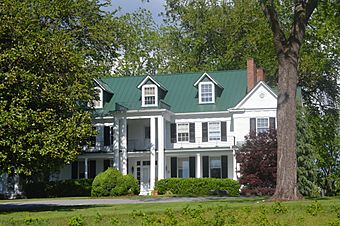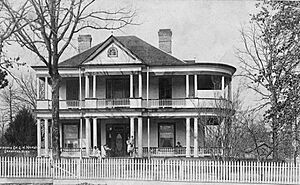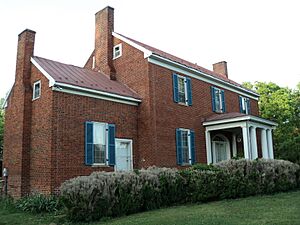Beaver Creek Plantation facts for kids
|
Beaver Creek Plantation
|
|

Front of the house
|
|
| Location | VA 108, Martinsville, Virginia |
|---|---|
| Area | 11.7 acres (4.7 ha) |
| Built | 1839 |
| Architectural style | Classical Revival |
| NRHP reference No. | 85000984 |
Quick facts for kids Significant dates |
|
| Added to NRHP | May 9, 1985 |
Beaver Creek Plantation was a very large farm in Martinsville, Virginia. It was owned by the Hairston family, who were Scottish immigrants. This plantation was a major center for growing tobacco. It was also important for the family's business of buying and selling enslaved people.
At Beaver Creek, enslaved people grew tobacco and other crops. They also made household items and raised farm animals. For example, they once tended a thousand yam plants. In a single day, they made 660 candles.
Contents
History of Beaver Creek Plantation
Beaver Creek was first built in 1776. It was owned by George Hairston. His father, Robert Hairston, bought the land from Col. Abram Penn. The land grant was huge, over 30,000 acres.
The Plantation House
The first house at Beaver Creek was destroyed by fire in 1837. George Hairston's son, Marshall, owned the land then. A new house was built using strong oak wood from nearby Henry County, Virginia. This new house was finished in 1839.
Life for Enslaved People
Many stories about the enslaved people at Beaver Creek have been kept. These stories help us understand their lives. For example, Sam Lion was an enslaved field worker. He earned extra money and bought his own woodworking tools.
One day, a new overseer wanted to borrow one of Sam's tools. Sam refused. After a disagreement, Sam fled the plantation. He hid in a forest for two months. Sam wanted to be with his family, so he returned. He was later shot while trying to escape again.
Other enslaved people also earned money. Ned and Clem were wagon drivers. They earned money by hauling extra loads for other farm owners. Clem also kept bees. He saved enough money to buy his own honey press. It cost $10 and two gallons of honey.
Plans for Freedom
Most enslaved people did not openly rebel. But at Beaver Creek, there was almost an uprising in 1812. An enslaved man named Tom confessed to a plan. This plan involved poisoning George Hairston and other slaveholders. It was meant to happen during a time when a British attack was expected.
The Hairston Family's Wealth
The Hairston family became very wealthy. They owned tens of thousands of acres of land. Their properties were in Virginia, North Carolina, and other Southern states. They started by growing tobacco. But their greatest wealth came from buying and selling enslaved people. They became one of the largest slaveholding families in the South.
The Hairstons married into other important local families. This included relatives of General Joseph Martin. The city of Martinsville is named after him. George Hairston, who married his cousin Matilda Martin, even served in the U.S. Congress.
The Hairston family came from Peter Hairston. He left Scotland for America in the early 1700s. He first lived in Pennsylvania. Later, he moved south to Virginia in the 1740s.
After the Civil War
The American Civil War ended in 1865. This led to the freedom of all enslaved people. This change greatly affected the Hairston family's business. Their wealth slowly decreased.
Today, the main house at Beaver Creek is a beautiful Classical Revival style mansion. It was built in 1839. The house and its gardens are sometimes open to the public. This happens during the Historic Garden Week in Virginia.
- Beaver Creek Plantation [1] - Virginia African Heritage Program
- "The Hairstons: An American Family in Black and White," Henry Wiencek, Macmillan, New York, 2000





